Petunia × atkinsiana
Petunia × atkinsiana (synonym: Petunia × hybrida) is a Petunia plant "nothospecies" (hybrid), which encompasses all hybrid species of petunia between P. axillaris and P. integrifolia.[1] Most of the petunias sold for cultivation in home gardens are this type and belong to this nothospecies.[2]
| Petunia × atkinsiana | |
|---|---|
| Common garden petunia | |
| Scientific classification | |
| Kingdom: | Plantae |
| Clade: | Tracheophytes |
| Clade: | Angiosperms |
| Clade: | Eudicots |
| Clade: | Asterids |
| Order: | Solanales |
| Family: | Solanaceae |
| Genus: | Petunia |
| Species: | P. × atkinsiana |
| Binomial name | |
| Petunia × atkinsiana (Sweet) D. Don ex W. H. Baxter | |
| Synonyms[1] | |
| |
| Wikimedia Commons has media related to Petunia × atkinsiana. |
| Wikispecies has information related to Petunia × atkinsiana |
Characteristics
Petunia × atkinsiana plants were originally produced by hybridisation between P. axillaris (the large white or night-scented petunia) and P. integrifolia (the violet-flowered petunia). P. axillaris bears night-fragrant, buff-white blossoms with long, thin tubes and somewhat flattened openings. The scent molecules emitted by the hybrids are generally similar to those from P. axillaris.[3]
Cultivation
Petunia seeds germinate in 5 to 15 days. Petunias can tolerate relatively harsh conditions and hot climates. They need at least five hours of sunlight every day. They grow well in low humidity, moist soil. Young plants can be grown from seeds. Petunias should be watered once every two to five days. In drier regions, the plants should be watered daily.[4] Dead corollas and seed-capsules should be removed to encourage further branching and flowering. Maximum growth occurs in late spring. The application of fertilizers once a month will help to promote quick growth. Petunias may readily be cultivated in tubs, window boxes, hanging baskets and other containers.
Categories
Grandiflora
This type of petunia has the largest flowers, up to 4 inches (100 mm) in diameter. Of all the petunias these have the widest variety of forms and colours but are the most likely to be damaged by heavy rain. There are four types of grandiflora and they are classified by their colours: ‘Daddy Series’ (shades of pink and purple), ‘Merlin Blue Morn’ (blue and white), ‘Supercascade Series’ (many colours) and ‘Ultra Series’ (many colours, including bi-colour).[5]
Hedgiflora (spreading)
Hedgifloras or spreading petunias (sometimes called ground-cover)[4] are characterised by their low height (usually about six inches), but they have a large spread (about three to four feet). They will cover a large area, provided they have adequate water and fertilization. ‘Purple Wave’ was the first introduced cultivar of spreading petunia and grows to a height of 4 inches (100 mm). ‘Tidal Wave’ is another spreading type of petunia, but is much taller (between sixteen and twenty-two inches). 'Surfinia' petunias are another type of spreading petunia propagated by cuttings. ‘Opera Supreme’ is a cultivar with large flowers.[6]
Multiflora
Multifloras are half the size of grandifloras, being 2 inches (51 mm) in diameter. They are not easily damaged in heavy rain and are more sun-tolerant. Multiflora petunia cultivars include: 'Carpet Series "(many colours) and 'Madness Series' (many colours). They spread quickly and are ideal for baskets.[5]
Milliflora
Millifloras are the smallest of the petunias, being about 1-inch (25 mm) across. These are commonly mixed with other plants in containers, along garden beds and edges. Millifloras are available in 'Fantasy Series' (red, purple, pink) and are the easiest to find. 'Supertunia Mini Series' (blue, pink, lilac, purple and white) are also available in the milliflora category. They tolerate harsh weather better when compared with grandifloras and multifloras.[5]
A common descriptor is Picotee, meaning that the edge of the flower is a different colour to the base, as in ‘Fortunia Pink Picotee’.
AGM cultivars
The following petunia cultivars have gained the Royal Horticultural Society's Award of Garden Merit:-[7]
- ’Celebrity Mid Blue’
- 'Conblue'[8]
- 'Conglow'[9]
- 'Constraw'[10]
- ’Explorer Pink’
- ’Explorer Purple’
- ’Frenzy Pink Morn’
- ’Frenzy Rose’
- 'Keilavbu'[11]
- ’Kerpril’
- ’Lavender Wave’
- ’Opera Supreme Blue’
- ’Opera Supreme Pink Morn’
- ’Opera Supreme Purple’
- ’Ramblin’ Nu Blu’
- 'Shihi Brilliant'[12]
- 'Storm Lavender'[13]
- 'Storm Salmon'[14]
- 'Storm Pink'[15]
- 'Sunpurve'[16]
- 'Suntosol'[17]
- ’Wave Pink Improved’
- ’Wave Purple’
Petunia cultivars showing different colours
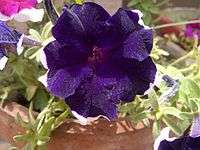 Petunia 'Sweet Sunshine Dark Violet'
Petunia 'Sweet Sunshine Dark Violet'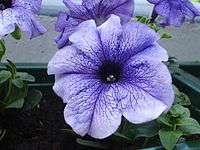 grandiflora Petunia 'Blue Daddy',[18]
grandiflora Petunia 'Blue Daddy',[18] Petunia 'Hula Hoop Red'
Petunia 'Hula Hoop Red'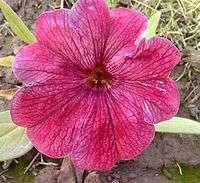 grandiflora Petunia 'Sugar'
grandiflora Petunia 'Sugar'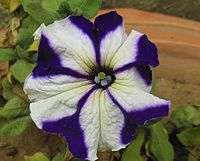 Petunia 'Ultra Blue Star'
Petunia 'Ultra Blue Star'- Petunia 'Blue Frost'
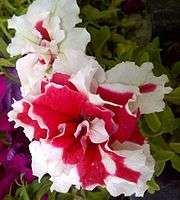 Petunia 'Red Pirouette'
Petunia 'Red Pirouette' grandiflora Petunia 'Bravo Salmon Veined'
grandiflora Petunia 'Bravo Salmon Veined'
References
- "Petunia ×atkinsiana". Germplasm Resources Information Network (GRIN). Agricultural Research Service (ARS), United States Department of Agriculture (USDA). Retrieved 17 April 2014.
- "Petunia (group)". Missouri Botanical Garden. Retrieved 12 September 2015.
- Koeduka, T.; Orlova, I.; Baiga, T. J.; Noel, J. P.; Dudareva, N.; Pichersky, E. (2009). "The lack of floral synthesis and emission of isoeugenol in Petunia axillaris subsp. parodiiis due to a mutation in the isoeugenol synthasegene". The Plant Journal. 58 (6): 961–9. doi:10.1111/j.1365-313X.2009.03834.x. PMC 2860387. PMID 19222805.
- Brown, Deborah. “Growing Petunias” University of Minnesota Extension Office. University of Minnesota. 2009. Web. 25 June 2009. http://www.extension.umn.edu/distribution/horticulture/DG1120.html Archived 2013-10-26 at the Wayback Machine
- Engebreston, Don., Williamson, Don. Annuals for Minnesota and Wisconsin. Lone Pine Publishing. 2004. Print.
- Russ, Karen. “Petunia”. Clemson Extension. Clemson University. September, 2007. Web. July 1, 2009<http://www.clemson.edu/extension/hgic/plants/landscape/flowers/hgic1171.html>
- "AGM Plants - Ornamental" (PDF). Royal Horticultural Society. July 2017. p. 75. Retrieved 24 April 2018.
- RHS plant selector: 'Conblue' Archived June 13, 2013, at the Wayback Machine
- RHS plant selector: 'Conglow' Archived June 13, 2013, at the Wayback Machine
- RHS plant selector: 'Constraw' Archived June 13, 2013, at the Wayback Machine
- RHS plant selector: 'Keilavbu' Archived June 13, 2013, at the Wayback Machine
- RHS plant selector: 'Shihi Brilliant' Archived June 13, 2013, at the Wayback Machine
- RHS plant selector: 'Storm Lavender' Archived June 13, 2013, at the Wayback Machine
- RHS plant selector: 'Storm Salmon' Archived June 13, 2013, at the Wayback Machine
- RHS plant selector: 'Storm Pink' Archived June 13, 2013, at the Wayback Machine
- RHS plant selector: 'Sunpurve' Archived June 13, 2013, at the Wayback Machine
- RHS plant selector: 'Suntosol' Archived June 13, 2013, at the Wayback Machine
External links
